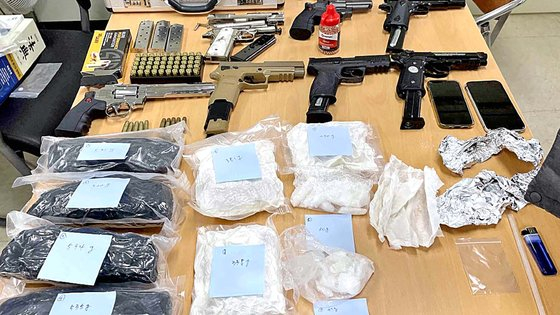A man in his 40s who smuggled a large amount of methamphetamine, along with handguns and live ammunition into South Korea from the United States has been indicted. The Seoul Central District Prosecutors’ Office’s Drug Crimes Special Investigation Team on Tuesday handed Jang Mo, 49, to trial on charges of violating the Special Narcotics and Firearms Act.
According to the investigation, Jang smuggled methamphetamine, one handgun, six simulated handguns, and 50 rounds of live ammunition in moving boxes from the United States in July last year, and brought them into South Korea through the Busan Port in September of the same year. Jang, who had been storing the items at his parents’ home in Nowon-gu, Seoul, was arrested after being raided on March 28. The seized 3.2 kilograms of meth was enough for more than 100,000 people to take at the same time, with a wholesale value of 500 million won and a retail value of 800 million won. Mr. Jang was found to have evaded customs enforcement by vacuum-packing the methamphetamine in a plastic bag and placing it inside a sofa table, and stashing the handgun and live ammunition in a toolbox.
This is the first time anyone has been caught smuggling drugs and firearms at the same time. Jang’s handgun was a Rock Island Armory M1911-A1, a lethal weapon with an effective range of 100 meters.
According to the prosecutors, Jang admitted that the drugs were for sale, but did not explain why he brought the handgun. Jang, a permanent U.S. resident, came to the U.S. about 15 years ago after studying and serving in the military in South Korea and worked as a drug dealer in Los Angeles before returning to South Korea last year.
Prosecutors believe Jang kept the entire shipment in storage since he couldn’t find the seller for the products yet.
Prosecutors began their investigation in December of last year with a tip. Unlike airports, where all passengers and cargo pass through X-ray screening, drugs being smuggled through ports are not easy to detect unless there is a tip.
Busan Port handled about 5.07 million TEUs (1 TEU = one 20-foot container) last year. This is a needle in a haystack for customs. Therefore, only a small portion of the cargo can be inspected. Smugglers prefer to use the so-called “walling” method, which involves filling cargo containers with foodstuffs such as garlic and leeks at the entrance and building a false wall inside to hide the drugs. Customs utilizes equipment that scans the entire container, but it is difficult to identify suspicious objects based on opacity and contrast from the scans.
Currently, Customs’ manpower and budget are insufficient to keep up with the increase in drug smuggling.
It is said that it costs 10 million to 20 million won every time they open a container for a sample test, tear off the packaging, examine it, and restore it to its original state. “It’s a daunting reality just to inspect suspicious containers,” said a prosecutor, adding, “You need intelligence to catch them, and you need a budget to collect quality intelligence.”
BY LEE CHANG-HOON [support@koreadaily.com]





